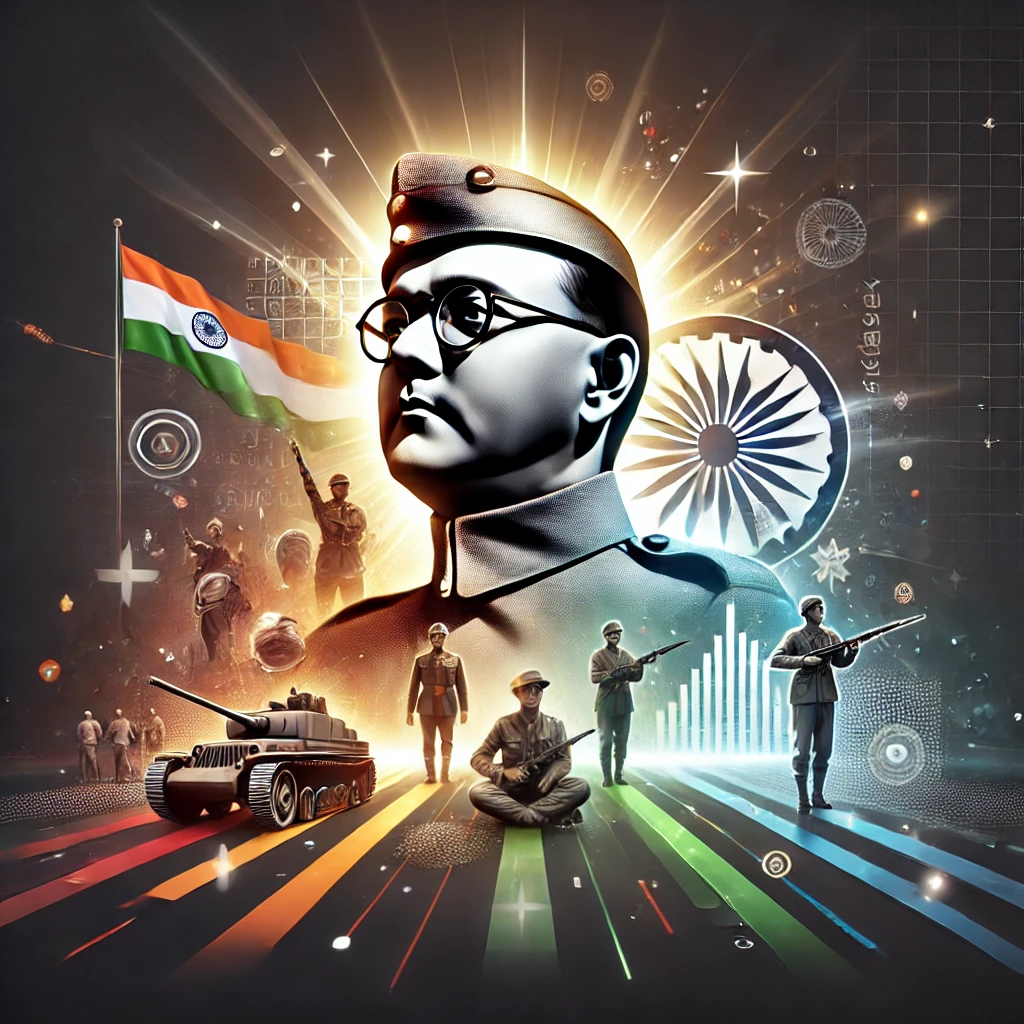Subhas Chandra Bose, one of India’s most dynamic freedom fighters, played a crucial role in the country’s struggle for independence. Unlike other leaders who pursued non-violent methods, Bose strongly believed that armed revolution and direct confrontation with the British were necessary for India’s freedom. His leadership of the Indian National Army (INA) and diplomatic efforts to seek international support for India’s independence made him a unique and influential figure in the freedom movement.
This article explores the life, ideology, and contributions of Netaji Subhas Chandra Bose, shedding light on his leadership, military campaigns, and impact on India’s fight for freedom.
Early Life and Ideological Development
Subhas Chandra Bose was born on January 23, 1897, in Cuttack, Odisha. His early education at the Presidency College and later at Scottish Church College in Kolkata shaped his nationalist views. He later moved to England and cleared the Indian Civil Services (ICS) examination, but he chose not to serve the British government, resigning from his position in 1921 to join the national movement.
Influence of Indian Nationalism
- Bose was deeply inspired by Swami Vivekananda and Aurobindo Ghosh, who emphasized spiritual nationalism and self-reliance.
- His association with C.R. Das, a nationalist leader, helped shape his belief in complete independence rather than mere dominion status under British rule.
- Unlike Mahatma Gandhi, who advocated non-violence, Bose believed that direct military action was necessary to overthrow colonial rule.
Bose’s Role in the Indian National Congress
Bose’s early political career was closely linked with the Indian National Congress (INC), where he rose to prominence as a radical leader.
Leadership Positions in the Congress
- In 1928, Bose opposed the Nehru Report, which recommended dominion status for India instead of full independence.
- In 1930, he became the Mayor of Kolkata and used the position to promote nationalist causes.
- In 1938, he was elected President of the Indian National Congress, emphasizing economic planning, industrialization, and military training for youth.
Conflict with Gandhi and Resignation from INC
- Bose was re-elected as Congress President in 1939, defeating Pattabhi Sitaramayya, Gandhi’s candidate.
- His radical views on immediate independence and militarization of the struggle clashed with the Gandhian faction.
- He resigned from Congress and formed the Forward Bloc, aiming to consolidate left-wing forces for armed resistance against the British.
Bose’s Struggle Against British Rule
After resigning from Congress, Bose intensified his efforts to seek international support and establish a military front against British rule.
The Escape from India (1941)
- British authorities kept Bose under house arrest in Kolkata due to his growing influence.
- In 1941, he escaped to Germany via Afghanistan and the Soviet Union, disguising himself to avoid British surveillance.
- His aim was to seek support from Axis Powers (Germany, Italy, and Japan) to free India from colonial rule.
Formation of the Indian National Army (INA)
Bose’s Journey to Japan
- In 1943, after realizing that Germany could not provide direct military assistance, Bose traveled to Japan, which had captured British territories in Southeast Asia.
- He took charge of the Indian National Army (INA), which was originally formed by Mohan Singh with Indian prisoners of war in Japanese-controlled regions.
- Bose restructured the INA and transformed it into a disciplined fighting force against British rule.
Azad Hind Government
- On October 21, 1943, Bose established the Provisional Government of Free India (Azad Hind Government) in Singapore.
- The government was recognized by Germany, Japan, Italy, and several other Axis countries.
- He adopted the slogan “Give me blood, and I will give you freedom”, inspiring Indians to join the struggle.
Military Campaigns of the INA
- Battle of Imphal and Kohima (1944)
- The INA, supported by Japanese forces, launched an attack on British positions in Northeast India.
- The aim was to enter mainland India and spark a nationalist rebellion.
- Despite initial success, the INA faced logistical challenges, monsoon conditions, and counterattacks from British and Allied forces.
- The campaign eventually failed, forcing INA troops to retreat.
- The INA, supported by Japanese forces, launched an attack on British positions in Northeast India.
- Participation in Burma Campaign
- The INA operated in Burma (Myanmar), launching guerrilla attacks against British forces.
- However, with Japan’s defeat in World War II, INA’s military strength weakened.
- The INA operated in Burma (Myanmar), launching guerrilla attacks against British forces.
Bose’s Mysterious Disappearance and Legacy
The Alleged Plane Crash (1945)
- On August 18, 1945, Bose reportedly died in a plane crash in Taiwan while traveling to seek Soviet assistance.
- Many theories emerged regarding his survival, with some believing that he lived in secrecy in Russia or India.
Impact of Bose on India’s Freedom Movement
- The INA trials at Red Fort (1945-46) created nationwide protests, pressuring the British government.
- The British feared that rebellions within the Indian armed forces could lead to a complete loss of control.
- Many historians argue that Bose’s military actions accelerated India’s independence in 1947.
Bose’s Vision for Independent India
Unlike many leaders, Bose had a clear vision for post-independence India:
- Strong Centralized Leadership – He admired leaders like Hitler and Mussolini for their centralized control but did not support their extremist policies.
- Socialist Economic Policies – Advocated state-led industrialization and economic planning.
- Secularism and Inclusivity – Promoted religious harmony and opposed caste discrimination.
- Military Strength – Believed in a strong defense force to protect India’s sovereignty.
Comparing Bose with Other Leaders
| Feature | Subhas Chandra Bose | Mahatma Gandhi | Jawaharlal Nehru |
|---|---|---|---|
| Approach to Freedom | Armed struggle, military action | Non-violent resistance | Constitutional reforms |
| International Strategy | Sought Axis Powers’ help | Focused on internal movements | Advocated diplomacy with British |
| Economic Policy | Socialist, state-led development | Village-based economy | Mixed economy model |
| Vision for Army | Militarization, strong defense | Non-violence, passive resistance | Strong military post-independence |
Conclusion
Subhas Chandra Bose’s contribution to India’s independence movement was unique and revolutionary. His leadership of the Indian National Army, diplomatic efforts to seek international support, and vision for a militarized struggle set him apart from other freedom fighters.
Though he did not live to see India’s independence in 1947, his legacy remains immortal in the history of India. His ideas of nationalism, self-reliance, and military preparedness continue to inspire generations.
His words, “It is blood alone that can pay the price of freedom. Give me blood, and I will give you freedom”, echo as a reminder of his undying commitment to India’s liberation.




